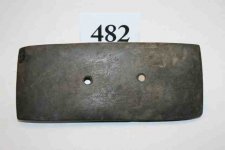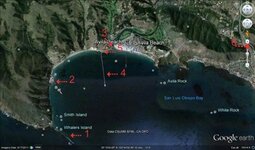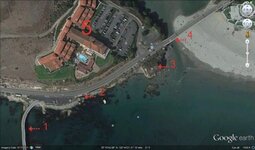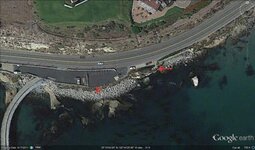BosnMate
Gold Member
- Sep 10, 2010
- 6,916
- 8,441
- Detector(s) used
- Whites MXT, Whites DFX, Whites 6000 Di Pro
- Primary Interest:
- Other
View attachment 714020
View attachment 714021
View attachment 714022
View attachment 714023
View attachment 714025
View attachment 714026
When WWII started everyone in California thought the Japanese were going to invade, and I was a pretty small kid, and some of my first memories were the army sending troops to the coast. I remember going with my dad, taking the soldiers coffee and donuts, and they had a huge (to me at the time) wooden cannon pointed out to sea, which I thought was really dumb, not understanding what they had in mind, but that's not part of this story. There might be people that read this that have been to Avila Beach, so I'm going to describe where the Indian mound was at the start of the war. In the 1800's there was a train from San Luis Obispo to Port San Luis, which is just past the small town of Avila, where the road dead ends still today. The railroad had to build a bridge across the mouth of San Luis creek to get to the port. When the tracks were removed, the bridge became a one lane auto bridge, and a mostly one lane road out to the fisherman's pier at the port, because cargo was no longer brought in to that location. The Union Oil Company then built a dock and brought oil tankers into Avila just on the other side of the bridge a couple of hundred yards or so. When the railroad had been built through there, they made a large cut through a huge Indian mound, leaving a small portion of the mound on the ocean side of the road, which when the war started was very close to the Union Oil dock. I mention the war, because the army dug an emplacement right smack in the middle of what was left of the mound, sandbags and roof and all. At this point, the mound looked every bit like a mesa out in the desert, flat topped, straight sides for a distance and sloughed dirt below the straight side, only the flat top wasn't very large. Maybe 25 by 50 feet, perhaps not that large, eroded at the ocean side, straight to the rocks below, and on the road side the sloughed dirt was situated so that a person could walk along that edge. I'm sorry, I have no picture of the location, and they have widened the road, and nothing is left there now. What do you suppose a couple of 8,9, or 10 year old boys would do with a place like that and an army emplacement, either for machine gun or observation, how ever the army used it, for us it was always a fighting hole, and we would get filthy in that sooty soil. The soldiers had dug up human remains, two skulls that I remember, and other bones. We of course took the skulls, but Mom made us take them back and bury them. The trail up to the top was by no means a good one, and our use and the weather kept eroding it, so that every time I went up there I found shell beads. I put them in my pocket, took them home, and lucky for me, Mom saved them all in a box, and those are the beads in the photo. The black sooty soil and shell midden was at least four feet thick, from the top of the mound, exposed on the sheer side towards the road, for the entire length. But a person had better luck finding stuff on the top, but every now and then I went along the side checking things out, and one day, there was a flat stone exposed, barley showing out of the dirt, located about in the middle of the sooty soil. In other words, if a person was digging from the top, it would have been two to three deep. When I pulled it out, it was covered with greasy black dirt, which I should have left on it, but I was a kid and used detergent to clean it up. I remember thinking at the time that it was remarkable that something could stay that greasy being buried as long as that had been in there. I know it's an artifact due to the conditions in which it was found, but I sure don't know what they were using it for. I know abalone is too tough to eat without being pounded tender, but they would have probably used a heavier stone for that. Maybe a dish for eating, I don't really have any good ideas, something I can say it's gotta be this or that, so your ideas are welcome.
The picture next to the beads is stuff I picked up on top of the mound, a small abalone shell, a lower leg bone of a deer that they had broken to get the marrow out, some points that weren't perfect but still were brought home. In those days many a time if the point wasn't perfect it just got tossed, left for someone else to find. There are some more beads in with the stuff, but it's mostly shell from stuff they ate. The Spanish built a mission in San Luis Obispo in 1772, and in among all the shell beads I found three white glass trade beads, not pictured. The trade beads were found in the trail up to the top.
The yellowish bone on the right by the blue book is one that I dug up here in Oregon. I have no idea what it is, but I was digging a water line with a back hoe, and it came from three or four feet down, I thought that was interesting and kept it. It had darn sure been there for a long time, and that's all the bone I found, although I didn't look very hard.
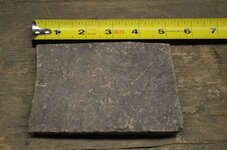
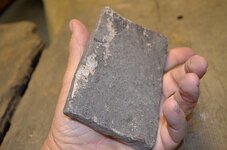
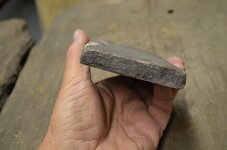
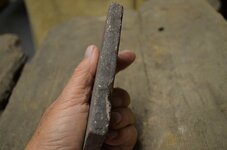
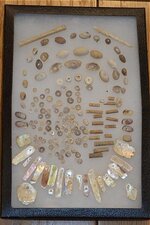
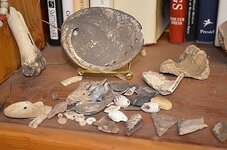
When WWII started everyone in California thought the Japanese were going to invade, and I was a pretty small kid, and some of my first memories were the army sending troops to the coast. I remember going with my dad, taking the soldiers coffee and donuts, and they had a huge (to me at the time) wooden cannon pointed out to sea, which I thought was really dumb, not understanding what they had in mind, but that's not part of this story. There might be people that read this that have been to Avila Beach, so I'm going to describe where the Indian mound was at the start of the war. In the 1800's there was a train from San Luis Obispo to Port San Luis, which is just past the small town of Avila, where the road dead ends still today. The railroad had to build a bridge across the mouth of San Luis creek to get to the port. When the tracks were removed, the bridge became a one lane auto bridge, and a mostly one lane road out to the fisherman's pier at the port, because cargo was no longer brought in to that location. The Union Oil Company then built a dock and brought oil tankers into Avila just on the other side of the bridge a couple of hundred yards or so. When the railroad had been built through there, they made a large cut through a huge Indian mound, leaving a small portion of the mound on the ocean side of the road, which when the war started was very close to the Union Oil dock. I mention the war, because the army dug an emplacement right smack in the middle of what was left of the mound, sandbags and roof and all. At this point, the mound looked every bit like a mesa out in the desert, flat topped, straight sides for a distance and sloughed dirt below the straight side, only the flat top wasn't very large. Maybe 25 by 50 feet, perhaps not that large, eroded at the ocean side, straight to the rocks below, and on the road side the sloughed dirt was situated so that a person could walk along that edge. I'm sorry, I have no picture of the location, and they have widened the road, and nothing is left there now. What do you suppose a couple of 8,9, or 10 year old boys would do with a place like that and an army emplacement, either for machine gun or observation, how ever the army used it, for us it was always a fighting hole, and we would get filthy in that sooty soil. The soldiers had dug up human remains, two skulls that I remember, and other bones. We of course took the skulls, but Mom made us take them back and bury them. The trail up to the top was by no means a good one, and our use and the weather kept eroding it, so that every time I went up there I found shell beads. I put them in my pocket, took them home, and lucky for me, Mom saved them all in a box, and those are the beads in the photo. The black sooty soil and shell midden was at least four feet thick, from the top of the mound, exposed on the sheer side towards the road, for the entire length. But a person had better luck finding stuff on the top, but every now and then I went along the side checking things out, and one day, there was a flat stone exposed, barley showing out of the dirt, located about in the middle of the sooty soil. In other words, if a person was digging from the top, it would have been two to three deep. When I pulled it out, it was covered with greasy black dirt, which I should have left on it, but I was a kid and used detergent to clean it up. I remember thinking at the time that it was remarkable that something could stay that greasy being buried as long as that had been in there. I know it's an artifact due to the conditions in which it was found, but I sure don't know what they were using it for. I know abalone is too tough to eat without being pounded tender, but they would have probably used a heavier stone for that. Maybe a dish for eating, I don't really have any good ideas, something I can say it's gotta be this or that, so your ideas are welcome.
The picture next to the beads is stuff I picked up on top of the mound, a small abalone shell, a lower leg bone of a deer that they had broken to get the marrow out, some points that weren't perfect but still were brought home. In those days many a time if the point wasn't perfect it just got tossed, left for someone else to find. There are some more beads in with the stuff, but it's mostly shell from stuff they ate. The Spanish built a mission in San Luis Obispo in 1772, and in among all the shell beads I found three white glass trade beads, not pictured. The trade beads were found in the trail up to the top.
The yellowish bone on the right by the blue book is one that I dug up here in Oregon. I have no idea what it is, but I was digging a water line with a back hoe, and it came from three or four feet down, I thought that was interesting and kept it. It had darn sure been there for a long time, and that's all the bone I found, although I didn't look very hard.






Amazon Forum Fav 👍
Last edited:
Upvote
0


